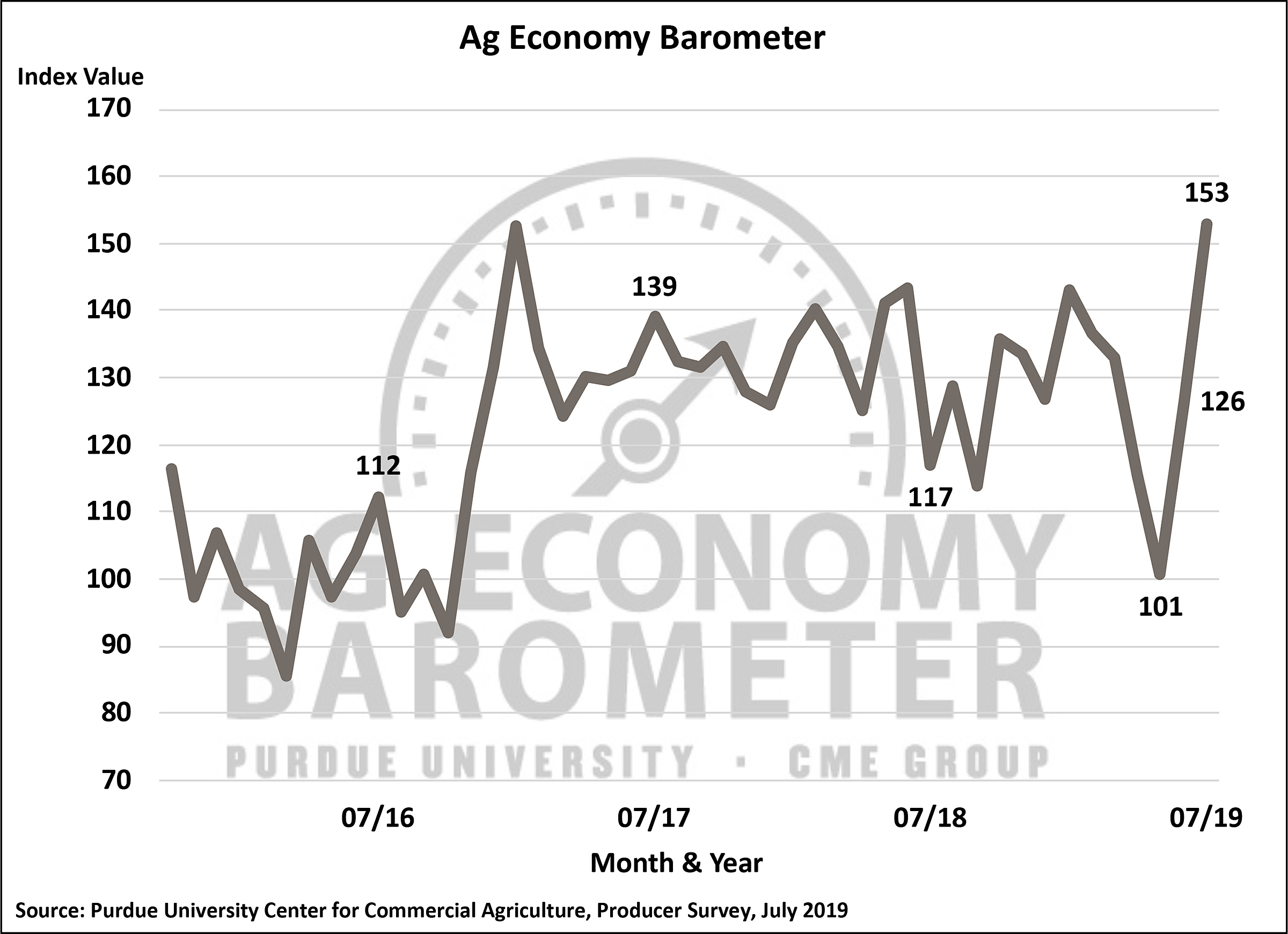



Confidence in the ag economy soars
Confidence in the ag economy soars; producers confirm large prevented plantings of corn and soybeansThe Purdue University/CME Group Ag Economy Barometer reading jumped to 153 in July, up 27 points from June, and up 52 points from May. Improving crop conditions after an extraordinarily wet planting season, combined with a late spring/early summer crop price rally, boosted farmer sentiment. This improvement occurred despite the fact that many producers were in the midst of filing prevented planting crop insurance claims and wondering about the size of the USDA’s 2019 Market Facilitation Payments (MFP). Results are based on a survey of 400 agricultural producers across the U.S. conducted from 15 to 19 July 2019, which was prior to USDA’s announcement of 2019 MFP payment rates.
A big driver of sentiment was producers’ improved expectations for current economic conditions. The Index of Current Conditions, a sub-index of the ag barometer, increased 44 points in July to a reading of 141, marking the largest one month improvement since data collection began in October of 2015. The barometer’s other sub-index, the Index of Future Expectations, also increased, up 18 points from June, to a reading of 159 in July.
“The Corn Belt is continuing to see better crop conditions and that has farmers, at least momentarily, breathing a sigh of relief. However, the agricultural economy is still in flux,” said James Mintert, the barometer’s principal investigator and director of Purdue University’s Center for Commercial Agriculture. “The impact of prevented planting on 2019 corn and soybean acreage and prices along with the outcome of trade talks with China remain unknown.”

© Purdue/CME Group Ag Economy Barometer/James Mintert
As a result of the late planting season, and the possibility of large prevented planting acreage not captured in their June Acreage report, USDA announced that they would re-survey farm operations in nearly all major corn and soybean states during July to better estimate actual planted acreage of both crops. The results from that survey will not be available until mid-August.
To help fill the information void, this month’s barometer survey asked corn and soybean growers if they are taking a prevented planting payment on any of the corn or soybean acreage they intended to plant in 2019. Although USDA extended their deadline to report prevented plantings to 22 July in affected states, most farmers completed their prevented planting claims by USDA’s original deadline of 15 July and were able to provide an accurate reading on their prevented planting acreage when this month’s ag barometer survey was conducted.
Twenty-five percent of corn/soybean growers in the survey said they are filing a prevented planting claim on some of their intended corn acreage while 24 percent said they are filing a prevented planting claim on some of their soybean acreage. In a follow-up question, producers who indicated they submitted a claim were asked what percentage of their intended acreage they will claim as prevented planting. Sixty-one percent of the farmers filing a prevented corn planting claim said their prevented planting totaled 15 percent or more of their intended corn acreage and 42 percent said that they did not plant 25 percent or more of their intended acreage. Meanwhile, 39 percent of soybean growers submitting a prevented planting claim said they did not plant between 15-25 percent of their intended soybean acreage. In contrast to corn growers, however, just 2 percent of soybean farmers with a prevented planting claim said they were not able to plant 25 percent or more of their intended soybean acreage.
Producers were also asked whether they feel now is a good or bad time to make large investments in their farming operations. In July, the Large Farm Investment Index, improved to a reading of 67, up 25 points from June and 30 points from May. This increase marked both the largest 2-month improvement in the index since data collection began in fall 2015 and the highest reading for the index since February 2018. Sentiment also spilled over into their expectations for increased land values. Short-term, the percentage of producers expecting land values to increase in the upcoming 12 months jumped from just 10 percent in June to 21 percent in July, the highest percentage expecting an increase in values since February 2018. Long-run, 53 percent of producers said they expect values to rise over the next 5 years compared to 45 percent who felt that way in June and 39 percent in May.
Read the full July Ag Economy Barometer report. This month’s report includes insights into whether producers expect a swift and favorable resolution to the ongoing trade dispute with China. The site also offers additional resources – such as past reports, charts and survey methodology – and a form to sign up for monthly barometer email updates and webinars. Each month, Dr Mintert also provides a short video analysis of the barometer results.
The Ag Economy Barometer, Index of Current Conditions and Index of Future Expectations are available on the Bloomberg Terminal under the following ticker symbols: AGECBARO, AGECCURC and AGECFTEX.










